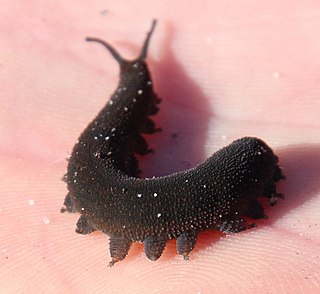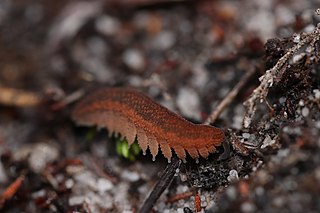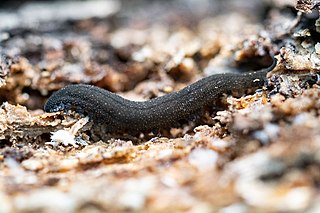Opisthopatus roseus is a species of velvet worm in the Peripatopsidae family. As traditionally defined, this species is rose pink with 18 pairs of legs. Known as the pink velvet worm, it is found only in the Weza Forest, a Mistbelt Forest in South Africa. Specimens have been found on the forest floor amongst leaf litter, beneath, and within fallen logs.
Opisthopatus is a genus of South African velvet worms in the family Peripatopsidae. The number of legs in this genus range from 16 pairs to 18 pairs. Mothers in this genus give birth to live young. In particular, this genus exhibits matrotrophic viviparity, that is, mothers in this genus retain eggs in their uteri and supply nourishment to their embryos, but without any placenta.

Peripatopsidae is one of the two living velvet worm families.
Opisthopatus cinctipes is a species of velvet worm in the Peripatopsidae family. This species has 16 pairs of legs, all with claws and all used for walking. The color of the dorsal surface varies from blue to olive green. Females range from 7 mm to 50 mm in length, whereas males range from 6 mm to 36 mm. Like other velvet worms in this genus, this species exhibits matrotrophic viviparity, that is, mothers in this genus retain eggs in their uteri and supply nourishment to their embryos, but without any placenta. The type locality is in South Africa.
Opisthopatus amatolensis is a species of velvet worm in the Peripatopsidae family. This species has 16 pairs of legs. The type locality is in South Africa. The validity of this species is uncertain: Although some authorities deem O. amatolensis to be invalid even as a subspecies of O. cinctipes, a similar species also found in South Africa, other authorities recognize O. amatolensis as a separate species, citing the significant distance between the type localities of these two species.
Opisthopatus amaxhosa is a species of velvet worm in the family Peripatopsidae. This species is a clade in the O. cinctipes species complex. This species has 16 or 17 pairs of legs in both sexes and varies from light to dark pink on the dorsal surface and from dark to light brown on the ventral surface. Males of this species range from 12 mm to 14 mm in length. Also known as the Xhosa velvet worm, this species is found in the Eastern Cape province in South Africa.
Opisthopatus drakensbergi is a species of velvet worms in the family Peripatopsidae. This species is a clade in the O. cinctipes species complex. This species has 16 pairs of legs. Specimens are brown and slate black with a line down the middle of the back and a brown ventral surface. The original description of this species is based on a male holotype measuring 13 mm in length. This species is found at high altitude in the forests of the Drakensberg mountains in KwaZulu-Natal province in South Africa.
Opisthopatus highveldi is a species of velvet worm in the family Peripatopsidae. This species is a clade in the O. cinctipes species complex. This species has 16 pairs of legs and varies in color from brown to black to indigo. The original description of this species is based on two holotypes ranging from 16 mm to 17 mm in length. Also known as the Highveld velvet worm, this species is found in indigenous forest patches along the Highveld in Mpumalanga province in South Africa.

Opisthopatus kwazululandi is a species of velvet worm in the family Peripatopsidae. This species is part of the O. cinctipes species complex. This species has 16 pairs of legs. The color of its dorsal surface varies from brown to rose pink, and the ventral surface ranges from light brown to creamy white. The original description of this species is based on a male holotype measuring 16 mm in length and a female holotype measuring 22 mm in length. Also known as the coastal velvet worm, this species is found in Eastern Cape province and Kwazulu-Natal province in South Africa.
Opisthopatus laevis is a species of velvet worm in the Peripatopsidae family. This species has 16 pairs of legs. The type locality is in South Africa. The validity of this species is uncertain: Some authorities consider O. laevis invalid even as a subspecies of O. cinctipes, a similar species also found in South Africa, but other authorities recognize O. laevis as a separate species, citing the significant distance between the type localities of these two species.
Opisthopatus natalensis is a species of velvet worm in the Peripatopsidae family. This species has 16 pairs of legs. The type locality is in South Africa. The validity of this species is uncertain: Although some authorities have deemed O. natalensis to be a subspecies of O. cinctipes, a similar species also found in South Africa, and others regard O. natalensis as invalid even as a subspecies, still other authorities recognize O. natalensis as a separate species, citing the significant distance between the type localities of these two species.
Ruhbergia bifalcata is a species of velvet worm in the family Peripatopsidae. This species has 15 pairs of legs in both sexes. The type locality is in New South Wales, Australia.
Ruhbergia brevicorna is a species of velvet worm in the Peripatopsidae family. This species has 15 pairs of legs in both sexes. The type locality is in New South Wales, Australia.
Ruhbergia rostroides is a species of velvet worm in the Peripatopsidae family. This species has 15 pairs of legs in both sexes. The type locality is in New South Wales, Australia.
Peripatopsis balfouri is a species of velvet worm in the Peripatopsidae family. This species has 18 pairs of clawed legs. Also known as the blue velvet worm, this species ranges from 9 mm to 22 mm in length. The type locality is in South Africa.

Peripatopsis capensis is a species of velvet worm in the Peripatopsidae family. This species has 18 pairs of legs: 17 pregenital leg pairs with claws plus one strongly reduced last pair without claws or spinous pads. Females of this species range from 9 mm to 70 mm in length, whereas males range from 6 mm to 54 mm. The native range of this species is limited to the Cape Peninsula of South Africa.
Peripatopsis intermedia is a species of velvet worm in the Peripatopsidae family. This species is about 33 mm long and has 19 pairs of legs: 18 pregenital leg pairs plus a last pair of much reduced legs. The type locality is in South Africa. Although some authorities doubt the validity of this species and deem it to be a junior synonym of P. balfouri, others consider these two to be separate species, citing the distance between their type localities.

Peripatopsis lawrencei is a species of velvet worm in the Peripatopsidae family. This species has 18 pairs of legs: 17 pregenital leg pairs plus one last pair that is strongly reduced and without claws or spinous pads. This species is restricted to the Theewaterskloof-Overstrand region of South Africa.

Peripatopsis moseleyi is a species of velvet worm in the Peripatopsidae family. Males of this species have 20 to 24 pairs of legs with claws ; females have 19 to 23 pairs of legs with claws. Females range from 11 mm to 75 mm in length, whereas males range from 9 mm to 50 mm. The type locality is in South Africa.

Peripatopsis overbergiensis, the Overberg velvet worm, is a species of velvet worm in the Peripatopsidae family. This species usually has 19 pairs of legs: 18 pregenital leg pairs plus one last pair that is strongly reduced and without claws or spinous pads. Some individuals, however, have only 18 leg pairs. This species is limited to the Overberg region of South Africa.





